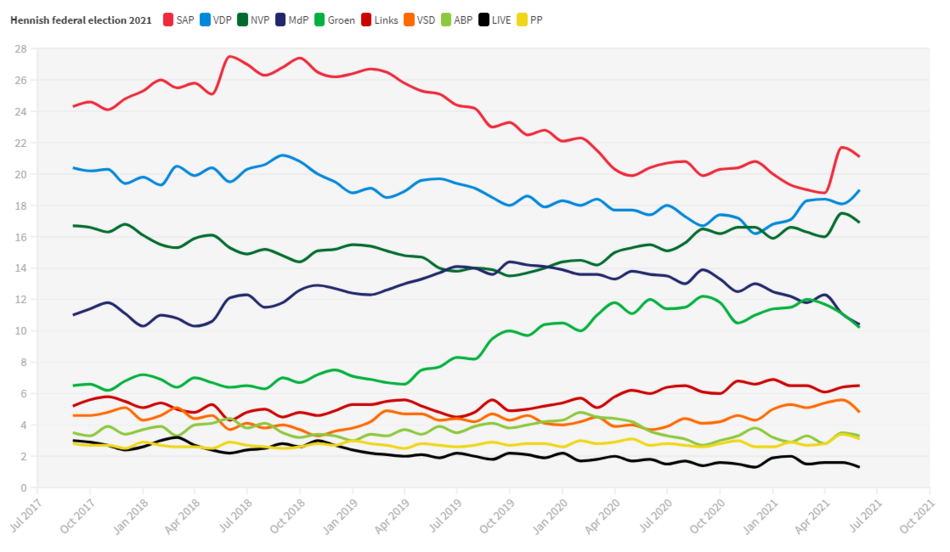User:Lyonsland/sandbox3: Difference between revisions
| Line 137: | Line 137: | ||
|13 | |13 | ||
|- | |- | ||
| <noinclude>[[File: | | <noinclude>[[File:Oudkessel Witburg.png|20px]]</noinclude> [[Oudkessel-Witburg]] | ||
|7 | |7 | ||
|- | |- | ||
Revision as of 14:49, 14 July 2021
| |||||||||||||||||||||||||||||||||||||
All 180 seats in the Chamber of Deputies 91 seats needed for a majority | |||||||||||||||||||||||||||||||||||||
|---|---|---|---|---|---|---|---|---|---|---|---|---|---|---|---|---|---|---|---|---|---|---|---|---|---|---|---|---|---|---|---|---|---|---|---|---|---|
| |||||||||||||||||||||||||||||||||||||
| |||||||||||||||||||||||||||||||||||||
Federal elections will be held in Hennehouwe on 3 September 2021 to elect all 180 members of the 28th Chamber of Deputies.
Background
Date
Article 42.2 of the Basic Law (Algemene Wet) states that a new Chamber of Deputies shall be elected no later than 28 days after the fourth anniversary of the first sitting of the current Chamber of Deputies, excluding public holidays, and that the date of the election must be held no less than 28 days but no more than 56 days after the dissolution of the pevious Chamber. Article 42.3 states that the first sitting of the new Chamber must occur within 28 days after the election date, excluding public holidays.
The Electoral Law of 2000 legislates for fixed-term election dates, automatically scheduling an election for the first Friday of September four years after the previous election, or the second Friday of September if the former falls on a public holiday. An election prior to the fixed date can be called for in the Chamber via a two-thirds supermajority vote. Under the Law, the election is scheduled for 3 September 2021. It is expected that the 27th Chamber of Deputies will be dissolved on 21 July 2021, after which election campaigning can begin.
Electoral system
The 180 members of the Chamber of Deputies are elected by open list proportional representation in 10 multi-member constituencies corresponding to the 10 regions of Hennehouwe, with seats allocated according to the Berger method. The allocation of seats remains unchanged from the 2017 election.
There is no electoral threshold, meaning the effective threshold depends on the size of the region: in the smallest region, Oudkessel-Witburg (7 seats), the effective threshold is around 10%, whilst in the largest region, Flamia (40 seats), it is closer to 2-2.5%. Seats are allocated to the regions in proportion to population, with a review of seat distribution carried out one year after the last census. For an outright majority in the Chamber, a party (or coalition of parties) must have at least 91 seats. Due to the nature of Hennehouwe's multi-party system, it is rare for any one party to singlehandedly obtain a parliamentary majority, and thus coalitions and/or agreements between different parties is necessary.
Electors vote by casting a preference for a personal candidate from their chosen list, rather than voting for a party list outright. If a candidate receives a quota of either 20% of 1/xth of votes (x equalling the number of seats in that region) or 33% of the total votes for their own list, they will bypass the rest of the list in the allocation of seats regardless of their placement on the electoral list. If multiple candidates from a list pass this threshold, their ordering is determined based on the number of votes received. Otherwise, the remaining seats are allocated according to the placement of candidates on the list. In regions with more than 24 seats, parties are limited to a maximum number of candidates equating to two-thirds the total number of seats. Due to the current distribution of seats, only Flamia and Lower Stegeren are affected by this change. In all other regions, the maximum number of candidates on a list is the total number of seats.
| Region | Seats |
|---|---|
| 40 | |
| 9 | |
| 19 | |
| 32 | |
| 13 | |
| 7 | |
| 12 | |
| 21 | |
| 15 | |
| 12 | |
| 180 |
